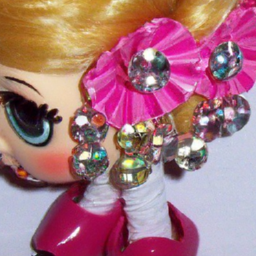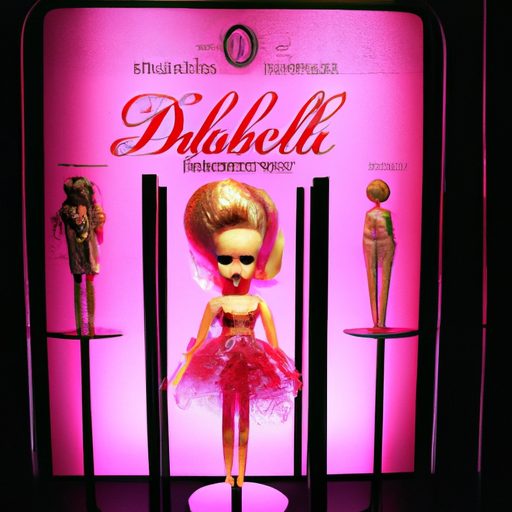
In this article, you’ll learn about the creator of Barbie and the fascinating story behind this iconic doll. You’ll discover the vision and creativity behind Barbie, and how she has become a symbol of beauty and fashion for generations of children.
Barbie was created by Ruth Handler, the co-founder of Mattel, along with her husband Elliot Handler. Inspired by their daughter’s fascination with paper dolls, Ruth came up with the idea of creating a three-dimensional doll that girls could dress up and play with. She aimed to provide young girls with a toy that encouraged imagination, creativity, and the idea that they could be anything they wanted to be. Ruth named the doll after her own daughter, Barbara, and Barbie was born. Since her introduction in 1959, Barbie has become a global phenomenon, evolving with the times and reflecting changes in society and popular culture.
The Creation of Barbie
The Inception of Barbie
Barbie, the iconic doll that has captured the hearts of millions of children and adults alike, was created by Ruth Handler. Ruth was a visionary entrepreneur who recognized the need for a doll that could inspire imagination, promote independence, and break gender stereotypes.
The Vision of Ruth Handler
Ruth, co-founder of the toy manufacturing company Mattel, had a unique vision for Barbie. She wanted to create a doll that would not only be a plaything but also serve as a source of inspiration and empowerment for young girls.
Early Designs and Prototypes
Before Barbie became the doll we all know and love today, there were several early designs and prototypes. Ruth and her team at Mattel worked tirelessly to refine the doll’s appearance, fashion choices, and overall concept.
The Finalization of Barbie
After numerous iterations and market research insights, Barbie was finally ready for launch. The official introduction of Barbie was a momentous occasion that would forever change the toy industry.
Ruth Handler: The Mastermind
Ruth Handler’s Background
Ruth Handler’s entrepreneurial spirit and drive set her apart from others in the business world. She had a knack for spotting opportunities and creating innovative products.
Inspiration from Her Daughter
Ruth’s daughter, Barbara, played a significant role in inspiring her mother’s vision for Barbie. As Ruth observed Barbara’s playtime, she noticed a gap in the doll market and a need for a more realistic and versatile doll.
The Birth of Mattel
Ruth, along with her husband Elliot Handler, co-founded the toy company Mattel. Starting from a small garage workshop, Mattel quickly became successful, producing various toys and games.
Ruth Handler’s Role in Barbie’s Creation
Ruth was not only a co-founder of Mattel but also an integral part of Barbie’s creation. She played an active role in the design process, marketing strategy, and overall vision for the doll.
The Inception of Barbie
Identifying the Gap in the Doll Market
Ruth Handler recognized that the dolls available in the market at that time were limited in their diversity and lacked the ability to inspire imaginative play.
Conceptualizing the Ideal Doll
Ruth envisioned a doll that would be a reflection of the real world, with different hair colors, skin tones, and body types. She wanted a doll that girls could relate to and that would encourage them to dream big.
The Name ‘Barbie’
The name ‘Barbie’ was inspired by Ruth’s daughter Barbara. Ruth felt that it was the perfect name for her creation, as it was catchy and easy to remember.
The First Barbie Doll
The first Barbie doll was introduced to the world in 1959. She had blonde hair, blue eyes, and wore a black and white striped swimsuit. Barbie instantly captivated the hearts of young girls everywhere.
The Vision of Ruth Handler
Breaking Gender Stereotypes
One of Ruth’s core objectives with Barbie was to break gender stereotypes. She wanted girls to see that they could be anything they wanted to be, whether it be a doctor, astronaut, or CEO.
Encouraging Imaginative Play
Ruth believed that imaginative play was crucial for childhood development. Barbie’s extensive collection of clothing, accessories, and playsets allowed children to create their own stories and explore different roles.
Promoting Career Aspirations
Barbie’s various career-themed dolls and playsets aimed to inspire girls to dream big and pursue their passions. From astronaut to chef, Barbie showed that there were no limits to what girls could achieve.
Fostering Independence in Girls
Ruth wanted Barbie to be a symbol of independence for girls. By allowing them to create their own narratives and storylines, Barbie encouraged girls to develop their own identities and embrace their individuality.
Early Designs and Prototypes
Fashion and Appearance Evolution
Over the years, Barbie’s fashion choices and appearance have evolved to reflect the changing times. From glamorous evening gowns to trendy casual wear, Barbie has always been at the forefront of fashion.
Collaboration with Designer Charlotte Johnson
Ruth Handler collaborated with designer Charlotte Johnson to create some of Barbie’s most iconic outfits. Together, they ensured that Barbie’s wardrobe was always stylish and reflective of current trends.
Testing and Refinement
Before Barbie’s launch, extensive testing and refinement took place to ensure that the doll met the highest standards of quality and playability. Ruth wanted Barbie to be a doll that could stand the test of time.
Market Research Insights
Ruth and her team at Mattel conducted market research to understand the wants and needs of their target audience. This valuable insight helped shape Barbie into the beloved doll she is today.
The Finalization of Barbie
The Official Launch
Barbie’s official launch in 1959 was met with tremendous excitement and anticipation. The doll quickly became a sensation, capturing the imagination of girls around the world.
Impact and Reception in the Market
Barbie’s impact on the market was immense. She quickly became one of the best-selling dolls of all time, and her popularity only grew over the years.
Barbie Becoming an Icon
Barbie’s influence extended beyond the toy industry. She became an icon, representing beauty, fashion, and empowerment. Barbie has remained a beloved symbol of inspiration for generations of girls.
Continued Evolution of Barbie
Throughout the years, Barbie has continued to evolve and adapt to the changing times. Mattel has introduced new body types, skin tones, and career-themed dolls, ensuring that Barbie remains relevant and inclusive.
Ruth Handler’s Background
Entrepreneurial Spirit
Ruth Handler’s entrepreneurial spirit was evident from a young age. She had a natural ability to spot opportunities and turn them into successful ventures.
Co-Founding Mattel with Her Husband
Ruth and her husband, Elliot Handler, founded Mattel in 1945. Their joint efforts and determination laid the foundation for the success of the company.
Successes and Innovations Prior to Barbie
Before Barbie, Mattel had already experienced successes and innovations. The company introduced popular toys such as the Uke-A-Doodle and the Burp Gun, establishing itself as a leading toy manufacturer.
Ruth Handler’s Personal Drive
Ruth’s personal drive and determination were key factors in her success as an entrepreneur. She was not afraid to take risks and push boundaries, which ultimately led to the creation of Barbie.
Inspiration from Her Daughter
Observing Her Daughter’s Play
Ruth closely observed her daughter Barbara’s playtime and noticed the limitations of the dolls available in the market. This observation sparked her desire to create a more realistic and versatile doll.
Identifying Existing Doll Limitations
Ruth recognized that the dolls available at the time were mainly baby dolls and lacked the ability to inspire open-ended play and imagination.
Desire for a More Realistic and Versatile Doll
Ruth wanted to create a doll that would be a reflection of the real world. She believed that a more realistic and versatile doll would encourage girls to engage in imaginative play and explore different possibilities.
Understanding Childhood Development
Ruth understood the importance of play in a child’s development. She believed that dolls played a significant role in shaping a child’s understanding of the world and themselves.

The Birth of Mattel
From Garage Workshop to Toy Manufacturer
Mattel started as a small garage workshop, where Ruth and Elliot Handler began producing picture frames. However, their entrepreneurial spirit led them to pivot the business into the toy industry.
Early Mattel Successes
Mattel experienced early successes with toys such as the “Music Box Pocket Radio” and the “Ponytail” Barbie doll. These achievements laid the groundwork for the future success of the company.
Transition into Doll Production
The transition into doll production was a significant milestone for Mattel. Ruth’s vision for Barbie propelled the company into a whole new realm of creativity and innovation.
Investing in Research and Development
Ruth recognized the importance of investing in research and development to stay ahead of the competition. Mattel’s commitment to innovation has been a driving force behind the success of Barbie and other toys.
Conclusion
Barbie’s enduring legacy as an empowering and influential doll is a testament to the vision and determination of Ruth Handler. Ruth’s commitment to breaking gender stereotypes, promoting imaginative play, and fostering independence in girls has left an indelible mark on popular culture and society. As Barbie continues to evolve and adapt to the changing world, her impact is sure to continue resonating with generations to come.














